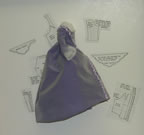3-D Map
Dressed for dinner, a sack dress circa 1770-1775.
Dining in the 18th century was often a formal
affair for many gentry families. George Washington and his family dined
with guests so often that he remarked in his diary one day that they “dined
alone.” Here is the process I used to create a 3-D map of a lady's
dress circa 1770–1775.
Planning
|

|
Front view of sack dress.
Click for more detail. |
First I had to choose the pattern that I would
use. I selected the sack gown, or robe à la française, because
it is appropriate to the second half of the 18th century, and the pieces
would be more managable in the scaled down version of the dress than those
of a polinaise or English-back gown.
I considered creating the dress to fit a 12"
manikin. However, since the size of the woman who wore the original dress
was unknown, I might have been in a situation where after rescaling the
pattern (from eighth-inch scale to the manikin's fifth-inch scale) the
dress still wouldn't fit the manikin properly. I therefore decided that
I would make the dress, then find a form to display it.
 |
Side view of sack dress.
Click for more detail |
I was unable to find an appropriate printed
fabric in the eighth-inch scale, and chose to use an irridescent taffeta
because it was period appropriate and would give the garment more life
than the flat color of a plain taffeta. The ribbon for the trim was the
only trim available that I could use and remain true to scale.
I could not scale the threads in the fabric
or those used to sew the garments. Nor are the seam allowances to scale.
The limitations of the materials chosen for the project make these inconsistencies
necessary. The inconsistencies in the scale do not interfer with the use
of the map to understand the spacial arrangement of an 18th century lady's
formal dress.
Construction
 |
Aerial view of sack dress.
Click for more detail. |
I used Janet Arnold's Patterns of Fashion
to cut the fabric pieces, and some of her notes were helpful in the construction.
The instructions were not sufficient for a modern seamstress to construct
the garment without further guidance; I was able to draw on my experience
of creating full scale 18th century dresses to construct the gown. The
fabric is stitched with back stitch, combination stitch, running stitch,
and top stitch.
|

|
Rear view of sack dress.
Click for more detail. |
Pleating the folds in the back of the garment
were particularly tricky, as the scale made it nearly impossible to use
pins to hold the fabric. Basting stitches had to serve the place of pins,
and can be seen in the portion of the gown closest to the foamcore. By
contrast, the pleats closest to the viewer have been top stitched in a
period appropriate fashion.
Initially my plan was to split the gown exactly
at the mid-point. That proved too difficult without having the gown come
apart, and so I compromised and decided to show about two-thirds of the
gown instead of the original half that I had planned. An added benefit
of showing two-thirds of the gown is that the viewer can see the funtioning
of the pleats in the back to better advantage.
The dress is mounted on an armiture of wire
and fabric inserted in the sleeve and bodice of the gown, then glued with
a hot glue gun to the foamcore. Due to scale, the fabric in the skirts
of the gown and petticoat did not require extra support to produce the
proper shape for the side extension, and so there is no armiture replacing
where the pocket hoops would be in a full-size gown.
Lessons Learned
It took me awhile to conceive of the project
as a map of a gown rather than a scaled replica of a gown. I kept trying
to build it as it should be in a real, full-sized garment, only smaller.
That often did not work. Once I made the paradigm shift, the project became
more managable.
The scale is a bit too small to successfully
show the impact of dress design elements on the movement and comfort of
the wearer. If I had to do it again, I would want the garment to show
the limited range of motion of ladies dressed in this attire, which could
be used to add interpretive depth to our understanding of women's lives
in the 18th century.
Finally, I would mount the gown in a slightly
different manner, so that the train of the gown trailed behind, along
a “floor,” instead of hanging down. As it is, it appears as
if the gown were mounted crooked on the board because there is no floor.
|